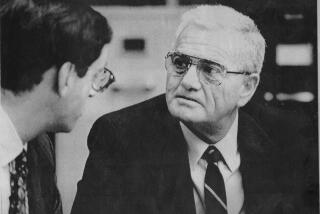DNA evidence in Grim Sleeper case was taken legally, judge rules
A judge ruled Tuesday that DNA evidence that led to accused Grim Sleeper serial killer Lonnie Franklin Jr. was lawfully obtained from a pizza slice, cups and napkins seized by a police officer who posed as a restaurant busboy in 2010.
Appearing on the stand for the first time, Franklin testified that he was attending a birthday party July 5, 2010, at Johnâs Incredible Pizza Co. in Buena Park when the DNA samples were taken.
Two days later, he was arrested by Los Angeles police.
Defense attorneys Seymour Amster and Louisa Pensanti had argued in pretrial hearings that the officer cleared Franklinâs plates and utensils before he was finished and were therefore taken illegally. The attorneys also argued that Franklin had a reasonable expectation that his plates would be thrown into a pile with others, which would make it impossible for police to definitely prove which remnants belonged to him.
âI felt it would be mixed with the rest of the trash,â Franklin said on the stand, drawing sighs of frustration from victimsâ families in the courtroom.
Los Angeles County Superior Court Judge Kathleen Kennedy rejected the defenseâs argument as âspecious and ridiculous,â noting that no reasonable person would think about where their trash went if they didnât think they were under police surveillance.
âIf he were really concerned about such things, he would not eat or he would take his trash with him,â Kennedy said. âThe fact of the matter is, the defendant ate his food like anybody else, and when it was taken away, it was abandoned ... and he no longer had a reasonable expectation of privacy.â
Franklin, 61, is charged with killing 10 women over a 22-year period. He has been held without bail since his arrest. He is also charged with the premeditated attempted killing of an 11th victim.
The former LAPD garage attendant and city garbage collector targeted vulnerable women, including prostitutes and drug addicts, prosecutors allege. Seven of the killings occurred from 1985 to 1988, and the others from 2002 to 2007.
Franklin became known as the Grim Sleeper because of the decade that passed without any known killings. Police say Franklin has been linked to at least six other homicides, although he has not been charged in any of those deaths.
Frustrated by their inability to find the Grim Sleeper, whose DNA did not match samples in a law enforcement database, Los Angeles police in early 2010 asked the state to look for a DNA profile similar enough to be a possible relative of the killer.
State computers produced a list of 200 genetic profiles of people in the database who might be related to the serial killer. One of those profiles shared a common genetic marker with the DNA found at each of the 15 crime scenes.
The resulting pattern indicated a parent-child relationship. Knowing that the Grim Sleeper had to be a man, they tested the DNA of the 200 offenders whose profiles resembled the crime-scene DNA to determine whether any appeared to share the Y chromosome, which boys inherit from their fathers.
The test produced one match: the same profile as the match on the first test. Franklinâs son had been swabbed for DNA in 2009 after a felony weapons arrest.
Questioning on Tuesday was limited to Franklinâs felony convictions â grand theft auto, assault, battery, false imprisonment and receiving stolen property â and the time he spent at the pizza restaurant.
Franklin, who is scheduled to stand trial this summer, is due back in court Jan. 21 for another pretrial hearing.
More to Read
Sign up for Essential California
The most important California stories and recommendations in your inbox every morning.
You may occasionally receive promotional content from the Los Angeles Times.











